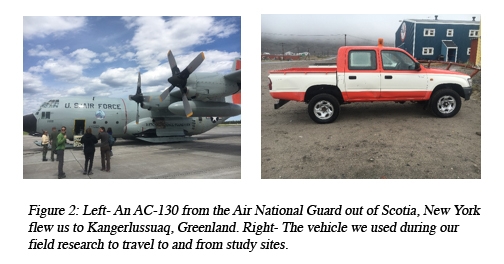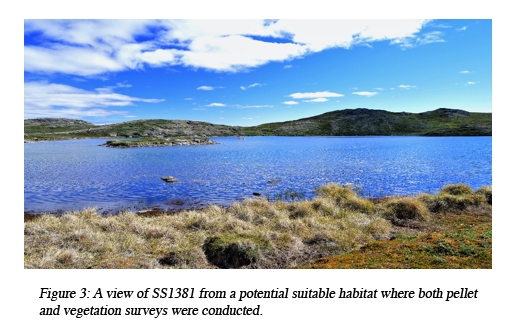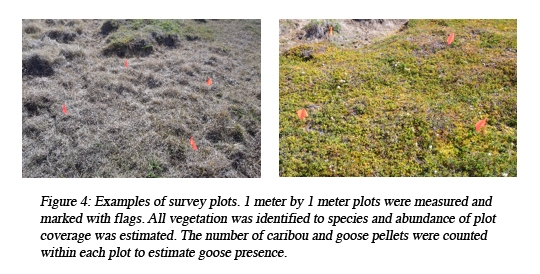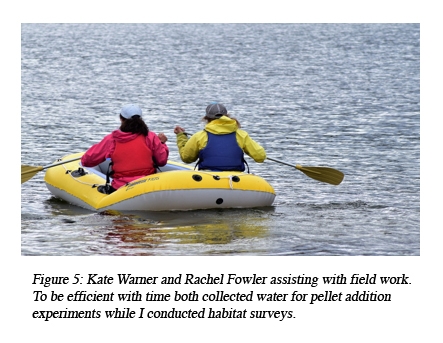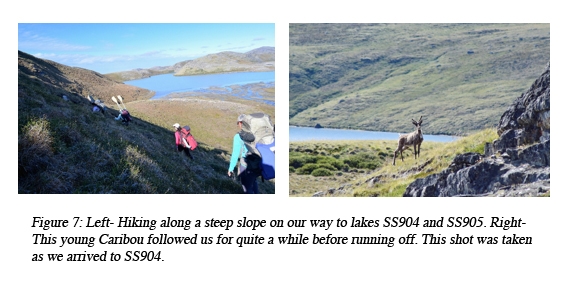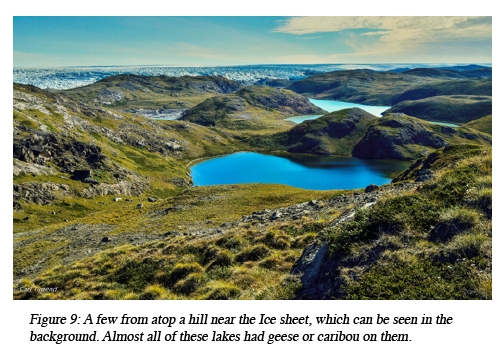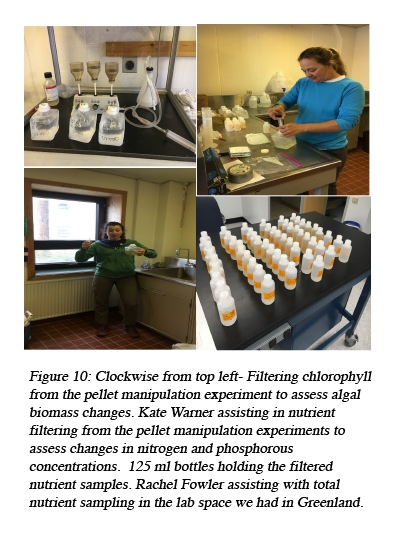Kangerlussuaq, Southwest Greenland
Effects of Geese & Caribou on Nutrient and Carbon Inputs to Arctic Lakes in Southwest Greenland
Field Team Members: Carl Tugend, Jasmine Saros, Kate Warner, Rachel Fowler, and Andrea Nurse
Dates: June 28th – July 20th 2016
Funding for this project was generously provided by the Dan and Betty Churchill Exploration Fund
Background:
Climate change generates a complex series of stressors, including alteration in temperature, elevated atmospheric CO2, and increased frequency and intensity of droughts and extreme flow events (Woodward et al. 2010). The Arctic is a fragile system which is especially susceptible to climate change, in particular to warming. Arctic landscapes and the structure of arctic food webs currently, and are predicted to, change due to climate. In particular, Arctic freshwater systems are vulnerable to small catchment changes due to their isolation and fragmentation. A small rise in temperature has the potential to cause profound changes in freshwater physical structures such as the extent and duration of ice cover and thermal stratification, and increases in temperature could also alter the catchment hydrology and vegetation (Ghislain et al 2010). This may have significant implications, as freshwater covers 0.8 percent of the earth’s surface but is home to approximately 6 percent of all species (Woodward et al. 2010). Freshwater systems located at higher latitudes, such as the arctic, could be sentinel systems due to their faster rates of warming (Hassan et al 2005).
Arctic freshwater ecosystems are important for wildlife, and in many cases accelerated warming leads to wildlife expansion and migration which can alter biogeochemical cycles (Ghislain et al 2010). Increased geese populations along with decreased caribou populations may alter these biogeochemical cycles by contributing inputs of nutrients and carbon through grazing and fecal input into Arctic lakes. The breeding grounds of geese usually cover an area 40 meters around the lake (Stroud 2011) allowing for significant nutrient input and studies suggest waterfowl derived nutrients can contribute 30-75% of nutrient loading rates in terrestrial and aquatic habitats (Ghislain et al 2010).
To date only a few studies have been conducted on the effects of geese and caribou on Arctic lake systems. One of these studies demonstrates that grazing and grubbing (the act of foraging under the soil surface) by geese have led to the large scale destruction of salt marshes along the Hudson Bay coast in Low Arctic Canada (Jefferies 1998; Walker et al. 2003). This was caused by the reduction of plant cover resulting in exposed soil which became susceptible to runoff and wind erosion (Van Der Wal et al. 2007). Geese populations have been on the rise since the turn of the century due to an increase in winter survivorship most likely due to southern agricultural practices allowing for a larger food supply and elevated winter body conditions (Ghislain et al 2010). Caribou populations however have been on the decline, which will also alter nutrient and carbon inputs due to a decrease in fecal pellets and grazing.
References:
Abraham, K. F. and R. L. Jefferies, 1997: High goose populations, causes, impacts and implications.– In: Batt, B. D. J. (ed), Arctic Ecosystems in Peril: Report of the Arctic Goose Habitat Working Group. U.S. Fish and Wildlife Service, Washington, D.C. and Canadian Wildlife Service, Ottawa, Canada: 7–72.
ACIA, 2004: Impacts of a Warming Arctic: Arctic Climate Impact Assessment. Cambridge University Press, New York.
Fox, Anthony D., Christian M. Glahder, and Alyn J. Walsh. “Spring Migration Routes and Timing of Greenland White-fronted Geese – Results from Satellite Telemetry.” Oikos 103.2 (2003): 415-25. Web.
Fox, Anthony D., Unpublished
Côté, Ghislain, Reinhard Pienitz, Gaute Velle, and Xiaowa Wang. “Impact of Geese on the Limnology of Lakes and Ponds from Bylot Island (Nunavut, Canada).” International Review of Hydrobiology 95.2 (2010): 105-29. Web
Hassan, R., Scholes, R. & Ash, N. 2005 Millenium Ecosystem Assessment. Ecosystems and human well-being: current state and trends, vol. 1. Washington, DC: Island Press.
Hinzman, Larry D., Neil D. Bettez, W. Robert Bolton, F. Stuart Chapin, Mark B. Dyurgerov, Chris L. Fastie, Brad Griffith, Robert D. Hollister, Allen Hope, Henry P. Huntington, Anne M. Jensen, Gensuo J. Jia, Torre Jorgenson, Douglas L. Kane, David R. Klein, Gary Kofinas, Amanda H. Lynch, Andrea H. Lloyd, A. David Mcguire, Frederick E. Nelson, Walter C. Oechel, Thomas E. Osterkamp, Charles H. Racine, Vladimir E. Romanovsky, Robert S. Stone, Douglas A. Stow, Matthew Sturm, Craig E. Tweedie, George L. Vourlitis, Marilyn D. Walker, Donald A. Walker, Patrick J. Webber, Jeffrey M. Welker, Kevin S. Winker, and Kenji Yoshikawa. “Evidence and Implications of Recent Climate Change in Northern Alaska and Other Arctic Regions.” Climatic Change 72.3 (2005): 251-98. Web.
Jefferies RL (1988) Pattern and process in arctic coastal vegetation in response to foraging by lesser snow geese. In: Plant Form and Vegetation Structure, Adaptation, Plasticity and Relationship to Herbivory (eds Werger M, Van der Aart P, During HJ, Verhoeven J), pp. 281–300. SPB Academic Publ., The Hague
Malecki, R.A., Fox, A.D. & Batt, B.A. 2000. An aerial survey of nesting Greenland Whitefrontedand Canada Geese in West Greenland. Wildfowl 51: 49-58.
Stroud RA 2011. A Study of interaction between moulting Canada Geese, Branta Canadensis interior and Greenland White-fronted Geese, Anser albifrons flaavirostris at different temporal and spatial scales in Isunngua, West Greenland. Unpublished B.SC. Thesis University of Whales, Bangor, UK.
Wal, René Van Der, Sofie Sjögersten, Sarah J. Woodin, Elisabeth J. Cooper, Ingibjörg S. Jónsdóttir, Dries Kuijper, Tony A. D. Fox, and A. D. Huiskes. “Spring Feeding by Pink-footed Geese Reduces Carbon Stocks and Sink Strength in Tundra Ecosystems.” Global Change Biol Global Change Biology 13.2 (2007): 539-45. Web.
Walker N, Henry H, Wilson DJ et al. (2003) The dynamics of nitrogen movement in an Arctic salt marsh in response to goose herbivory: a parameterized model with alternate stable states. Journal of Ecology, 91, 637–650.



